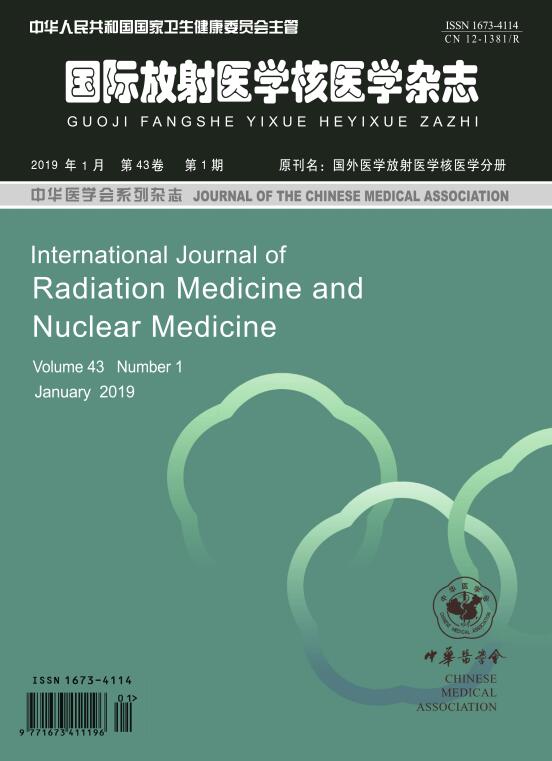-
PET/CT是将PET和CT两种先进的影像学技术有机地集合在一起的分子影像学设备。PET是采用正电子核素标记显像剂参与活体代谢,提供分子水平上反映体内代谢的影像,但对图像解剖结构显示不清楚;CT的分辨率高,图像具有精细的解剖结构信息,但缺乏功能信息。把两者有机地结合起来,实现了功能图像与解剖图像信息的互补,并且提高了诊断的灵敏度、特异度和准确率。但随着CT设备的广泛应用,潜在的辐射危害也引起了人们的关注[1]。PET/CT是肿瘤诊断和分期的最佳方法之一,但受检者所受辐射剂量必须充分考虑,以平衡检查的益处和辐射暴露的风险[2]。自动管电流调制(automatic tube current modulation,ATCM)技术能有效降低辐射剂量,近些年来得到了广泛应用[3-4]。笔者通过调节管电流区间和噪声指数(noise index,NI),评价ATCM技术对PET/CT中CT图像质量及受检者有效剂量(effective dose,ED)的影响。
HTML
-
将2017年10月至2018年7月在我科行PET/CT检查的90例成年受检者采用系统抽样方法分为A、B、C 3组,每组各30例。纳入标准:①明确有恶性肿瘤病史的成年受检者;②意识清晰、配合度较好者;③检查过程中体位无移动者。排除标准:①体内有金属支架影响图像质量者;②7 d内有钡灌肠或食道造影者;③有较重呼吸问题或无法配合者。A组:男性16例、女性14例,年龄24~78(53.7±12.74)岁;B组:男性12例、女性18例,年龄21~81(55.4±10.41)岁;C组:男性17例、女性13例,年龄22~79(56.6±11.48)岁。记录受检者身高、体重,并计算体质量指数(body mass index,BMI),BMI=体重/身高2。检查前患者或其家属均签署了知情同意书。
-
检查仪器为美国GE公司Discovery PET/CT 710,检查前去除身上所有影响图像质量的异物,体位为仰卧位,受检者双臂上举交叉于头顶,先行CT正、侧位定位扫描,然后进行ACTM扫描,范围为颅底至股骨上段。扫描条件:管电压120 kV,层厚3.75 mm,螺距0.984∶1,球管旋转速度0.6 s/转,A、B两组管电流区间为60~240 mA,NI分别为10、15,C组管电流区间为60~180 mA,NI为15,采用默认的迭代法重建图像。
-
屏蔽图像采集信息,由两位核医学科主治及以上医师对A、B、C 3组CT图像进行盲评打分。评分标准采用5分制[5]:5分,图像对比度好,噪声很小,完全满足诊断要求;4分,图像解剖结构较清晰,噪声少,满足诊断要求;3分,图像一般,噪声稍高,基本满足诊断要求;2分,图像较差,噪声大,有伪影,很难满足诊断要求;1分,图像无效,噪声大,伪影重,无法满足诊断要求。颈部CT图像选取下颌角层面,窗宽350 HU,窗位40 HU;胸部CT图像选取气管隆突层面,窗宽350 HU,窗位40 HU;腹部CT图像选取肝门层面,窗宽220 HU,窗位40 HU;盆腔CT图像选取髂总动脉分叉层面,窗宽250 HU,窗位40 HU。
-
CT图像客观评价层面与主观评价层面一致,颈部CT在胸锁乳突肌划定ROI,ROI面积为30 mm2;胸部CT在降主动脉划定ROI,ROI面积为100 mm2;腹部CT在脾脏内划定ROI,ROI面积为70~80 mm2;盆腔CT在右侧腰大肌内划定ROI,ROI面积为70~80 mm2。测定ROI内平均CT值及其标准差(standard deviation,SD),噪声用SD值表示[6]。信噪比(signal noise ratio,SNR)=CT值/SD值。
-
在CT剂量报告上读取并记录容积CT剂量指数(volume CT dose index,CTDIvol)和剂量长度乘积(dose length product,DLP)。ED采用DLP估算法[7-8]计算:ED=k·DLP,其中,k为加权因子,单位为mSv/(mGy·cm),DLP单位为mGy·cm。年龄和部位不同,k值也不同,成年人躯干k=0.015[7]。
-
采用SPSS22.0软件进行统计学分析,计量资料符合正态分布,采用均数±标准差(
$\bar x $
1.1. 一般资料
1.2. 检查方法
1.3. 图像质量评价
1.3.1. 图像质量主观评价
1.3.2. 图像质量客观评价
1.4. ED的计算
1.5. 统计学方法
-
A、B、C 3组患者的身高、体重、BMI的差异均无统计学意义(F=0.73、0.40、0.95,均P>0.05)(表1),具有可比性。2名医师对CT图像质量评分的一致性较好,Kappa值为0.69~0.83。3组患者所有图像质量评分均不低于3分,且差异均有统计学意义(F=3.77~14.42,均P<0.05)(表2)。A、B、C 3组患者的SD值和SNR差异均有统计学意义(F=38.01~64.20和F=32.09~81.62,均P<0.05)(表3)。A、B、C 3组患者的CTDIvol、DLP、ED的差异均有统计学意义(χ2=62.18、57.19和57.16,均P<0.05)(表4)。ED的两两比较,B组比A组低,差异有统计学意义(χ2=19.70,P<0.05);C组比B组低,差异有统计学意义(χ2=9.50,P<0.05);C组比A组低,差异有统计学意义(χ2=56.55,P<0.05)。
组别 例数 身高(m) 体重(kg) MBI(kg/m2) A组 30 1.62±0.09 56.53±9.88 21.63±3.01 B组 30 1.64±0.07 57.97±9.05 21.65±2.93 C组 30 1.61±0.09 58.63±8.94 22.59±3.24 F值 0.73 0.40 0.95 P值 0.487 0.672 0.389 注:表中,A、B、C 3组为采用系统抽样方法进行的分组。PET:正电子发射断层显像术;CT:计算机体层摄影术;MBI:体质量指数。 Table 1. Basic information of PET/CT of 90 patients(
$\bar x $ 组别 例数 颈部CT(分) 胸部CT(分) 腹部CT(分) 盆腔CT(分) A组 30 4.37±0.49 4.43±0.50 4.30±0.53 4.30±0.47 B组 30 4.06±0.45 4.16±0.46 4.00±0.45 3.97±0.49 C组 30 4.00±0.49 4.10±0.48 3.67±0.55 3.63±0.49 F值 4.96 3.77 11.58 14.42 P值 0.010 0.029 0.000 0.000 注:表中,A、B、C 3组为采用系统抽样方法进行的分组。PET:正电子发射断层显像术;CT:计算机体层摄影术。 Table 2. Subjective evaluation of CT image quality of PET/CT of 90 patients (
$\bar x $ 组别 例数 SD SNR 颈部 胸部 腹部 盆腔 颈部 胸部 腹部 盆腔 A组 30 11.90±2.83 12.07±1.55 18.17±2.99 17.96±3.06 4.35±0.71 3.20±0.52 2.96±0.49 3.07±0.61 B组 30 19.89±3.44 15.42±1.93 21.61±3.71 22.82±2.82 2.71±0.48 2.51±0.32 2.46±0.41 2.33±0.33 C组 30 20.67±3.63 16.22±2.15 26.03±3.74 25.65±2.54 2.61±0.56 2.39±0.41 2.03±0.34 2.07±0.26 F值 64.20 40.39 38.01 57.21 81.62 32.09 37.61 53.67 P值 0.000 0.000 0.000 0.000 0.000 0.000 0.000 0.000 注:表中,A、B、C 3组为采用系统抽样方法进行的分组。PET:正电子发射断层显像术;CT:计算机体层摄影术;SD:标准差(即:噪声值);SNR:信噪比。 Table 3. Objective evaluation of CT image quality of PET/CT of 90 patients (
$\bar x $ 组别 例数 CTDIvol(mGy) DLP(mGy·cm) ED(mSv) A组 30 12.44±0.53 998.45±96.04 14.98±1.44 B组 30 9.39±2.01 741.60±168.87 11.12±2.53 C组 30 7.05±1.03 571.29±97.41 8.57±1.46 χ2值 62.18 57.19 57.16 P值 0.000 0.000 0.000 注:表中,A、B、C 3组为采用系统抽样方法进行的分组。PET:正电子发射断层显像术;CT:计算机体层摄影术;CTDIvol:容积CT剂量指数;DLP:剂量长度乘积;ED:有效剂量。 Table 4. Radiation dose of PET/CT of 90 patients (
$\bar x $
-
PET/CT受检者所受辐射来源于两部分,一部分是PET扫描时注射的放射性显像剂18F-FDG,另一部分是CT扫描中的X射线。PET/CT对受检者产生的辐射剂量比单独PET扫描或者局部CT扫描所产生的辐射剂量明显增加[9]。在保证受检者图像质量足以满足临床诊断的同时,目前的观点普遍认为扫描剂量越低越好[10]。梁子威等[11]统计了2012年1月至2014年6月《中华核医学与分子影像杂志》和《Journal of Nuclear Medicine》报道的有关PET/CT检查中 18F-FDG的注射剂量,分别为3.7~7.4 MBq/kg和3.9~7.4 MBq/kg,多数为3.7~5.55 MBq/kg,注射剂量与受检者体重呈正比,产生的辐射剂量相对固定。
本研究主要通过调节管电流区间和NI,探讨ATCM技术在PET/CT中的实际应用。PET/CT中的CT扫描一次完成,包括颈部、胸部、腹部、盆腔等不同部位,由于厚度及组织构成变化很大,导致X射线的衰减差异明显,不同部位所需的管电流必然不同,使用固定的管电流模式显然无法满足这一需求且会导致辐射剂量相对较高。近年来,学术界和业界研究者都在积极探索减少辐射剂量且同时保持图像质量的方法,ATCM技术应运而生。ATCM是基于个体化因素、解剖结构的不对称性以及扫描区域内组织构成对X射线衰减差异较大这一事实,沿角度平面(XY平面)和(或)长轴(Z轴)方向上,通过在线或非在线方式实时调制管电流输出,减少不同投照角度上不必要的X射线输出以获得最佳X射线分布的一项技术。ATCM有两个关键设置参数:管电流区间和NI。管电流设置过高会使体型过小的受检者过度曝光从而导致不必要的辐射剂量,设置过低会使体型过大的受检者曝光不足从而导致伪影、噪声高,图像质量差,设置适当的管电流区间不仅能保证图像质量还能优化受检者的辐射剂量。预设NI是通过调整图像的噪声水平进一步调节管电流,NI每降低5%,图像噪声随之降低,但辐射剂量将会增加10%[12]。
本研究中设置A、B两组管电流区间为60~240 mA,NI分别为10、15;C组管电流区间为60~180 mA,NI为15,CT图像质量主观评分均不低于3分,可满足临床诊断要求。虽然管电流区间上限降低,NI增高,会导致SD增加,SNR降低,图像质量变差,评分变低,但CT剂量相关参数CTDIvol、DLP、ED也会相应降低。有文献报道,PET/CT中CT的辐射剂量高达80 mSv[13],本研究中A、B、C 3组的ED均远低于该文献报道结果,其中C组的ED与梁子威等[11]报道的关于仿真人体模型CT扫描得到的ED(8.12 mSv)相当。通过降低管电流区间上限,B组ED比A组降低;通过增加NI,C组ED比B组降低;通过降低管电流区间上限和增加NI,C组ED比A组降低。
降低管电流是降低CT辐射剂量的最佳方法,但管电流降低会导致密度分辨率受到光子噪声的影响,影像呈颗粒性,图像质量下降是无法弥补的缺陷[14]。如果进一步对C组进行降低管电流区间上限或者增加NI,可能会导致图像质量尤其是腹部和盆腔的图像质量无法达到诊断要求。因此,不能盲目追求低剂量,否则增加的防护代价往往得不偿失。
在PET/CT中应用ATCM技术,合理调节管电流区间及NI,在保证图像质量的同时可有效降低受检者的ED。医学影像中的ALARA(尽可能的低剂量)指导原则要求的是剂量优化,而不是纯粹降低剂量[15]。尽可能的低剂量指导原则中也并未具体说明多大的剂量是一定合适的[16]。在实际临床应用中可根据受检者的检查目的和诊断要求,设定相应的扫描参数。
利益冲突 本研究由署名作者按以下贡献声明独立开展,不涉及任何利益冲突。
作者贡献声明 周锐负责研究命题的提出、数据的分析总结、论文的撰写;陈晓良负责命题的设计与建立、指导审核及修订;余颂科负责数据的采集及处理;华俊、孟奔负责诊断评价。








 DownLoad:
DownLoad: